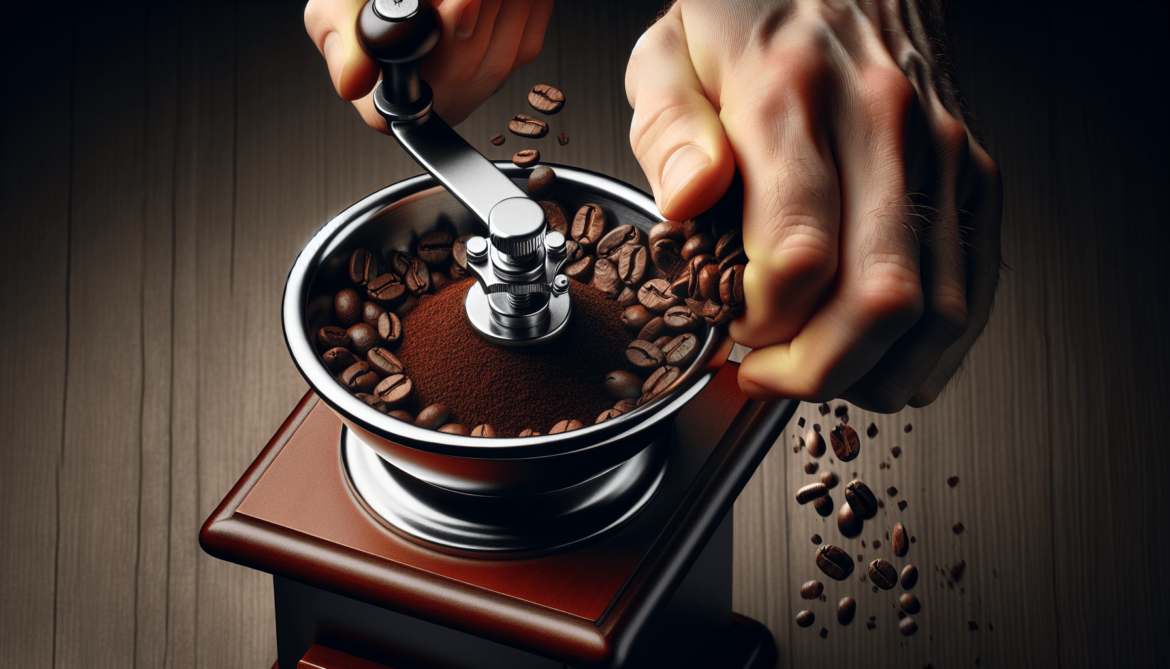You love the aroma of freshly ground coffee in the morning, but have you ever wondered about the techniques and tools behind the perfect grind? In this article, you’ll discover the secrets to achieving a consistent and flavorful grind that will elevate your coffee experience to new heights. From exploring different grinding techniques to unraveling the mysteries of various tools, get ready to unlock the world of coffee grinding and take your morning routine to a whole new level.
Manual Grinding
When it comes to grinding coffee beans, there are two main options: manual grinding and automatic grinding. Manual grinding involves using a hand grinder to grind the beans to your desired consistency. This method provides a more hands-on approach to coffee preparation, allowing you to have full control over the grind size and the brewing process.
Hand Grinder
A hand grinder, also known as a manual grinder, is a simple and affordable tool that allows you to grind coffee beans by hand. It usually consists of a handle attached to a small container where the beans are placed. By manually rotating the handle, you can grind the beans to your desired consistency. Hand grinders are portable and do not require electricity, making them a great option for outdoor activities or traveling.
Burr Grinder
A burr grinder is another type of manual grinder that uses a set of burrs (two abrasive surfaces) to crush the coffee beans. This method ensures a more consistent grind size compared to blade grinders, resulting in a better extraction and flavor in your coffee. Burr grinders offer adjustable settings to control the grind size, making them suitable for various brewing methods.
Automatic Grinding
If you prefer a more convenient and time-saving approach, automatic grinders are the way to go. These grinders use electric power to automatically grind the coffee beans, providing consistency and efficiency in the grinding process.
Blade Grinder
A blade grinder, also known as a propeller grinder, operates by rotating a blade at high speed to chop the coffee beans into smaller particles. While blade grinders are quick and easy to use, they tend to produce a less consistent grind size compared to burr grinders. This inconsistency can result in uneven extraction and a subpar taste in your coffee.
Burr Grinder
Similar to manual burr grinders, automatic burr grinders use burrs to crush the coffee beans and achieve a more uniform grind size. These grinders usually offer a range of grind settings, allowing you to adjust for different brewing methods. Burr grinders are considered the gold standard for grinding coffee due to their consistency and ability to preserve the beans’ flavor.
Grind Settings
Whether you choose a manual or automatic grinder, having adjustable grind settings is crucial. Different brewing methods require different grind sizes to optimize the extraction process. For example, a coarse grind is ideal for French press, while an espresso shot requires a fine grind. Having the flexibility to adjust the grind size ensures you can achieve the best flavor and consistency for your preferred brewing method.
Choosing the Right Grinder
Selecting the right grinder for your needs involves considering factors such as budget, grinder types, and grind consistency.
Budget
When choosing a grinder, it’s essential to determine your budget. Grinders range in price from affordable manual options to higher-end automatic machines. Consider how much you are willing to invest in your coffee brewing setup and choose a grinder that falls within your budget while still meeting your quality and convenience requirements.
Grinder Types
Understanding the different types of grinders available can help you make an informed decision. Manual grinders are generally more affordable and portable, making them suitable for those on a budget or who prioritize simplicity. Automatic grinders, on the other hand, offer more convenience and consistency, but often come with a higher price tag.
Grind Consistency
The consistency of your coffee grind plays a significant role in the final taste of your brew. Blade grinders tend to produce an inconsistent grind size, which can lead to over-extraction or under-extraction of the coffee during brewing. Burr grinders, whether manual or automatic, offer a more consistent grind, resulting in a better extraction and a more balanced flavor profile.
Grind Size
Grind size refers to the coarseness or fineness of the coffee grounds. Different brewing methods require specific grind sizes to achieve the desired flavor and extraction. Here are the four main categories of grind size:
Coarse Grind
A coarse grind consists of larger particles and is commonly used for brewing methods such as French press and cold brew. The larger particles allow for a slower extraction process, resulting in a fuller-bodied cup of coffee.
Medium Grind
A medium grind falls between the coarse and fine grinds and is commonly used for drip coffee makers and pour-over methods. This grind size offers a balanced extraction, allowing for a well-rounded and flavorful cup of coffee.
Fine Grind
A fine grind consists of smaller particles and is typically used for espresso machines. The smaller grounds increase the surface area, allowing for faster extraction and a stronger, more concentrated flavor.
Turkish Grind
The Turkish grind is the finest grind size available and is specifically used for traditional Turkish coffee preparation. This extremely fine grind size ensures maximum extraction and a strong, rich flavor.
Grinding Techniques
Grinding coffee is not just about the grind size; it also involves various techniques that can significantly impact the final taste of your brew. Here are some essential grinding techniques to consider:
Dosing
Dosing refers to the amount of coffee you use per batch or serving. It is crucial to measure the appropriate amount of coffee to ensure consistency and avoid over or under-extraction. Use a coffee scale or a measuring spoon to ensure accurate dosing every time.
Brewing Method
Different brewing methods require different grind sizes for optimal extraction. Be sure to adjust your grinder’s settings accordingly to match your chosen brewing method. Experimenting with different grind sizes can help you find the perfect balance and flavor profile for your preferred brewing technique.
Bloom
Bloom refers to the initial stage of brewing where hot water is poured over the coffee grounds, allowing them to release gases. This process is crucial for a well-extracted and flavorful cup of coffee. The grind size can affect the bloom time and the overall extraction, so make sure to adjust accordingly based on your preferred brewing method.
Grind Time
The amount of time you grind your coffee beans can also impact the extraction and flavor. Grinding for too long can lead to excessive heat, which can alter the taste of the coffee. It is recommended to grind just before brewing to maintain freshness and preserve the optimal flavor.
Grinding for Different Brewing Methods
Each brewing method has its own specific grind size requirements to achieve the best flavor. Here are some guidelines for grinding coffee for popular brewing methods:
French Press
For French press, a coarse grind is recommended to prevent fine particles from slipping through the metal mesh filter. This grind size allows for a longer steeping time, resulting in a rich and full-bodied cup of coffee.
Pour Over
Pour over methods such as V60 or Chemex typically require a medium grind size. This allows for a balanced extraction and a clean, flavorful cup of coffee. Adjust the grind size slightly depending on the specific pour-over device you are using.
Espresso
Espresso machines require a very fine grind size to achieve the high pressure needed for extraction. The fine grounds ensure a short extraction time and a concentrated shot of espresso with a thick crema. It is crucial to dial in your grinder’s settings carefully to achieve the perfect extraction.
Grinding Tips and Tricks
To enhance your grinding experience and ensure the best flavor in your coffee, here are some helpful tips and tricks:
Use Freshly Roasted Beans
The quality of your coffee beans plays a significant role in the final taste of your brew. Opt for freshly roasted beans as they tend to have better flavor and aroma compared to older beans. Look for a roast date on the packaging and try to consume the beans within a few weeks of that date for optimal freshness.
Grind Just Before Brewing
To maximize the flavor and aroma of your coffee, it is best to grind the beans just before brewing. This prevents oxidation and helps retain the volatile compounds that contribute to the coffee’s overall taste experience. Invest in a good grinder and establish a routine of grinding right before you start the brewing process.
Grind Size Adjustment
Don’t be afraid to experiment with different grind sizes to find the perfect one for your palate and preferred brewing method. Small adjustments in the grind size can have a significant impact on the taste of your coffee. Keep a record of your grind settings and brewing variables to replicate your favorite cup in the future.
Clean Your Grinder
Regular maintenance and cleaning of your grinder are essential to ensure consistent performance and avoid any stale coffee residue affecting the flavor of your brew. Refer to the manufacturer’s instructions for proper cleaning techniques and frequency. A clean grinder ensures a clean and delicious cup of coffee every time.
Beyond Coffee: Grinding Spices
Grinding tools are not limited to coffee beans alone. You can also utilize your grinder for grinding spices, adding a whole new dimension to your culinary adventures.
Spice Grinder
While some grinders may come with designated spice grinding attachments or separate spice grinder models, many coffee grinders can handle grinding spices as well. However, be cautious as some spices may leave behind strong aromas or flavors, so it’s best to have a dedicated grinder for spices if you regularly grind a wide variety.
Cleaning
To avoid cross-contamination between coffee and spices, it is crucial to clean your grinder thoroughly before switching between the two. Disassemble the grinder and clean each component meticulously. Ensure all spice residues are removed to maintain the integrity of the coffee’s flavor.
The Impact of Grinding on Coffee Flavor
The grinding process has a significant impact on the flavor, aroma, and overall quality of your coffee. Here are a few ways in which grinding affects your brew:
Extraction Rate
The grind size influences the extraction rate of the coffee. A finer grind provides a larger surface area for water contact, resulting in a faster extraction. Conversely, a coarser grind slows down the extraction process. Finding the right balance is essential for achieving optimal flavor and avoiding over-extraction or under-extraction.
Uniformity
Grinders that offer a consistent grind size ensure uniform extraction and flavor distribution. Inconsistent grind sizes can lead to under-extraction of finer particles and over-extraction of coarser particles, resulting in an imbalanced and potentially bitter taste. Investing in a high-quality grinder helps maintain grind uniformity for a superior coffee experience.
Aroma
Grinding your coffee beans just before brewing releases the aroma compounds locked within the beans. These volatile compounds contribute to the overall aroma and fragrance of your coffee. By grinding fresh, you can experience the full olfactory delight of your chosen beans and enhance the sensory pleasure of your morning cup.
Investing in a High-Quality Grinder
If you are serious about your coffee brewing journey and want to elevate your coffee experience, investing in a high-quality grinder is a wise choice. Here’s why:
Consistency
A high-quality grinder ensures consistent grind sizes, resulting in even extraction and a well-balanced flavor. Consistency is key when it comes to brewing exceptional coffee, and a reliable grinder can help you achieve that consistency with each brew.
Durability
A well-built grinder with quality materials is designed to withstand frequent use and last for years. By investing in a durable grinder, you can enjoy the convenience and satisfaction of grinding fresh coffee without having to worry about premature wear and tear.
Grind Size Options
High-quality grinders often offer a wide range of grind size options, allowing you to fine-tune your coffee experience for different brewing methods. Having the ability to adjust the grind size gives you the flexibility to explore various flavors and extraction profiles, opening up a world of possibilities for your coffee journey.
In conclusion, grinding coffee is a fundamental step in the coffee brewing process that significantly impacts the flavor and overall quality of your brew. Whether you choose a manual or automatic grinder, prioritize consistency, adjustability, and the ability to achieve the desired grind size for your preferred brewing method. Explore different techniques, experiment with grind sizes, and invest in a high-quality grinder to unlock the full potential of your coffee beans and elevate your coffee experience to new heights. Happy grinding!



